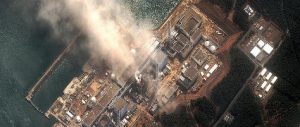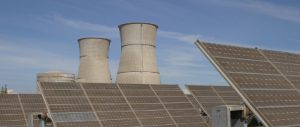Behind the local government premises in the city of Jiayuguan stands a nondescript six-storey building. A plaque on the door announces it as the planning office for China National Nuclear Corporation’s (CNNC) spent nuclear fuel reprocessing facility. Pointing to the building, a local official boasted: “Once that’s finished, there will be no limit to growth here.”
The “that” in question is a uranium-recycling project worth 200 billion yuan (US$30.4 billion). In November 2010, CNNC and French firm Areva signed an agreement to build a plant capable of handling 800 tonnes of spent fuel here in Gansu province, north-west China.
A number of experts involved in selecting the location for the plant, which plans to recover uranium for reuse, have confirmed that Jinta county, to the north of Jiayuguan, has been chosen. Given that nuclear facilities are required to be sited away from residential areas, if the scheme goes ahead (last week China suspended approvals of new nuclear projects, following Japan’s nuclear disaster at Fukushima) its employees will be located outside the county, but still nearby – in Jiayuguan, or the cities of Jiuquan and Yumen.
And so this massive project has caused something of a stir in these small and remote Gobi cities.
These places are sparsely populated, lack resources and rely on a limited range of industries to provide employment. The jobs and investment that come with a project worth hundreds of billions of yuan is just the lifeline they’ve been hoping for.
Jiayuguan has a brand new airport terminal and is in the process of building a high-speed rail scheme. These were in part made possible by the area’s nuclear promise: “Mentioning that project was really helpful when we were applying for the money and land,” a local official told us.
Nuclear dilemma
The safety and environmental risks of nuclear power have long been points of controversy – controversy that has escalated in intensity in the week since a major earthquake in Japan triggered a series of explosions and radiation leak at the country’s Fukushima nuclear plant. Since the world’s worst nuclear accident at Chernobyl in 1986, there has also been constant opposition to the processing of nuclear waste.
In early November last year, a train carrying 123 tonnes of highly radioactive waste left France en route for Germany. Almost 50,000 protestors attempted to block its route. The waste had earlier been sent from a German nuclear power station to an Areva processing plant in France and was being returned to an interim storage facility back in Germany.
This was not the first time Areva had faced obstruction to one of its shipments. As a market leader in commercial reprocessing of nuclear waste, the company’s clients include nuclear plants in Germany, Russia and Japan. Nuclear waste is constantly moving back and forth between France and these nations – and is always accompanied by fierce protests.
According to a source close to the Gansu project, Areva made clear early in the partnership that it wanted the facility to be a processing centre for the whole of Asia. China is said to have backed this ambition. Professor Li Ning, head of the Energy Institute at Xiamen University, in south-east China, said: “In 2009, the Chinese nuclear-power sector witnessed South Korea’s success in exporting nuclear plants to the United Arab Emirates and became keen to do the same – to sell nuclear services to other nations.”
This means that the nuclear waste arriving in Gansu would not just come from within China, but is also very likely to be imported from neighbouring countries. However, some experts are concerned that the reprocessing technology might not yet be mature enough to deal with it.
Shao Mingchang, head of the nuclear fuel office at China’s Ministry of Environmental Protection (MEP), explained that the complex chemical processes involved in reprocessing raise certain safety issues. Reprocessing of spent fuel is also extremely expensive, and there are very high demands for working procedures, equipment and material.
On January 3 this year, an official announcement trumpeted a “breakthrough” in China’s nuclear fuel reprocessing technology, claiming it would “boost the utilisation rate of uranium 60-fold”.
A source close to the project explained the news: “It was actually a very strong signal to the French – if you don’t work with us, we can do it ourselves." China and France are engaged in a tug-of-war over the nature and ratio of investment in the 200 billion yuan (US$30.4 billion) project. “Areva is short on contracts at the moment, and its processing facilities have spare capacity,” added Tsinghua University researcher Chen Jing.
Since losing out to Korea in the US$20 billion (131 billion yuan) project to build four nuclear plants in the United Arab Emirates, Areva’s dominant position in the global nuclear sector has come under question. Meanwhile, the much-delayed opening of a nuclear reprocessing plant being built by a French-Japanese consortium at Rokkasho in north-eastern Japan, has been further postponed due to technical complications. (Japan’s earthquake is also reported to have caused problems at the plant, which is situated in the affected Tohoku region. A spent-fuel pool reportedly spilled over and power at the plant was lost.)
Obviously, for Areva, a major contract with China will help to plug the gap.
But dialogue between the two parties behind the Gansu project has soured over price. “Even if the cost came down to 100 billion yuan (US$15.2 billion), it would still be pricey for current French technology and equipment,” said Chen.
Despite this, and amid the wider controversy over nuclear waste, the project appears to be forging ahead – largely thanks to the support of CNNC, which controls every aspect of China’s nuclear sector. Professor Qian Jihui, honorary president of the Nuclear Power Institute of China and former deputy director general for technical cooperation at the International Atomic Energy Agency (IAEA), admitted: “CNNC gets a big order, paid for by the government, and boosts the reprocessing industry – it’s a very good deal for them.”
Can it wait?
The "urgent" need to deal with China’s lack of fuel-reprocessing technology was first raised in 2004. Gu Zhongmao, deputy chair of the technology committee at the China Institute of Atomic Energy, wrote to top politicians saying that China’s reprocessing technology “is two decades behind even India”. Gu’s remarks prompted national leaders to make public statements on the issue, though no action was taken.
According to an informed source, January’s reprocessing breakthrough was made at a research project run by a CNNC factory that has been operating for 24 years on total funding of less than 2 billion yuan (US$304 million). Many experts argue that there is no need to rush into commercial projects in a field where research takes so long.
Moreover, they say, recycling fuel only becomes commercially viable when the uranium price is high. At the moment uranium reclaimed from reprocessing is much more expensive than new material. “There is a precondition for starting reprocessing projects – a shortage of uranium,” said Qian.
Shao Mingchang, of the MEP, explained that, since natural uranium is the cheaper option, application of nuclear-fuel reprocessing is not yet widespread globally. Only when reprocessed fuel is used in fourth generation reactors (currently theoretical designs not expected to be ready for commercial deployment before 2030) will the economics improve, he said. And, when China’s existing nuclear-power stations were designed, plenty of storage for nuclear waste was included.
“Reprocessing the waste isn’t actually that urgent,” said Fu Xiangang, head of the China Nuclear Power Technology Research Institute.
In the last century, France, Britain and Russia opted to recover and reuse spent fuel, but other nations are taking a wait-and-see approach on grounds of economics, safety and technological maturity. This does not mean that research into the technology has halted. For example, the US Department of Energy has continued developing and improving reprocessing technology, with government support.
And one expert who participated in China’s “breakthrough” research project is confident about the future of reprocessing in his own country: “Cooperation with France would be long-term – building the reprocessing plant would take until 2020. But judging by our current level of technology, it’s very likely we could build our own plant by 2025.”
An earlier version of this article appeared in Southern Weekend. It was adapted by the authors for publication on chinadialogue.
Yuan Ying is a reporter at Southern Weekend and Wang Haotong an intern.
Homepage image from woshishui05 shows China’s Ling’ao nuclear plant.

